Delaware • New Jersey • Pennsylvania
New York • United States of America
- All About Freshwater Mussels
- Surveying Mussels & Looking Ahead
- Links to Learn More
- Hey Kids - Get Crafty! Make a Freshwater Mussel Hat
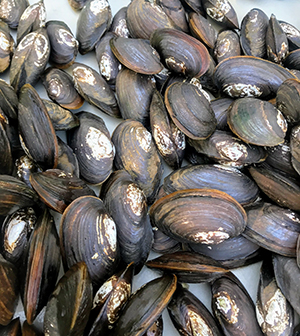 |
| Alewife floaters, a freshwater mussel. Photo by DRBC. |
Freshwater mussels are bivalve mollusks that live along, and in, the sandy bottoms of rivers, streams and lakes.
Freshwater mussels are one of the world's most diverse taxonomic orders, estimated at over 900 species. However, they are considered one of, if not the, most at risk animal group in the United States, with many species considered threatened or endangered by state and federal governments.
In the Delaware River Basin, there are over a dozen species of native freshwater mussels. Historically, freshwater mussels were abundant, but populations have drastically declined over time due to water pollution, overharvesting, habitat loss and tributary dams, which impede mussel distribution. Declines in fish populations that act as larval mussel hosts also impact mussel numbers. The reduced population of freshwater mussels in the Delaware River Basin is consistent with what's happening nationwide.
Freshwater Mussel Life Cycle
Freshwater mussels have complicated reproduction strategies dependent on specific fish hosts. For example, the Eastern elliptio, the most common freshwater mussel in the Delaware River Basin, relies on five species of fish to act as host; two are the brook trout and American eel.
Female mussels internally fertilize their eggs with the sperm of nearby males. Once fertilized, the larvae are released as fish pass by, and attach to the fish's gills until they are larger. They then drop off and settle on the stream bottom. This can be quite a distance away from where the female mussel released her eggs, helping transport mussels throughout a watershed.
Why Care about Freshwater Mussels?
They provide valuable ecosystem services by increasing water clarity, enriching habitats, and stabilizing bed erosion.
Most importantly, as filter-feeders, freshwater mussels clean the water in which they live, improving water quality.
They suck water in, trap solids (dirt, algae, and other pollutants) in their gills, and then release clean, filtered water back into the water column.
Each mussel can filter 10 gallons of water or more every day.
Mussels are sensitive to pollution and also erosion and sedimentation; they are more likely to be found in cleaner waterways. They also can live a long time - 50 years or more.
These factors make freshwater mussels good long-term indicators of water quality and habitat condition.
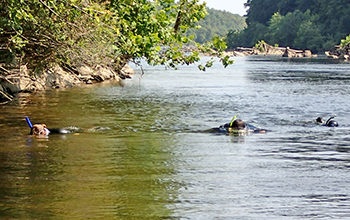 |
| DRBC staff surveying for freshwater mussels. Photo by DRBC. |
The importance of freshwater mussel populations within an ecosystem has driven several projects within the Delaware River Basin.
In the early 2000s, the United States Geological Survey - Northern Appalachian Research Laboratory (USGS-NARL) conducted comprehensive, qualitative mussel surveys of the Upper Delaware Scenic and Recreational River and the Delaware Water Gap National Recreation Area.
In 2013, to build on this previously-completed survey work, DRBC and USGS-NARL, partnered to conduct a study to provide a snapshot of mussel distribution and density in the Lower Delaware Scenic and Recreational River, the river section just below the Delaware Water Gap. Surveys were conducted over a period of seven weeks.
• Read more: DRBC Completes Lower Delaware River Mussel Survey
The surveyors found more than 25,000 mussels! While the most common species was by far the eastern elliptio, six other species were found, as well as juveniles.
• View Report: Freshwater Mussel Community Composition and Relative Abundance in the Lower Delaware River (pdf 691 KB; 2014)
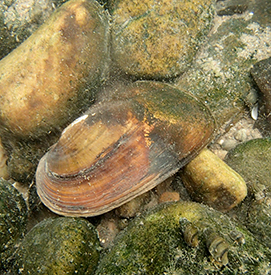 |
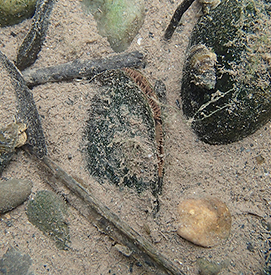 |
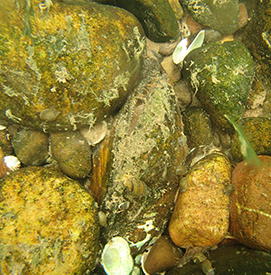 |
| Eastern floater. Photo by DRBC. | Eastern elliptio. Photo by DRBC. | Yellow lampmussel. Photo by DRBC. |
In September 2019, the DRBC installed 24 mussel cages in the Delaware River across six locations, three upstream of the Lehigh River (Phillipsburg, N.J.; Sandts Eddy, Pa. and Belvidere, N.J.) and three downstream of the Lehigh (Raubs Island, Pa., Riegelsville, N.J. and Riegelsville, Pa.). The cages were checked in July 2020 and pulled in September 2020.
The objectives of this pilot study were to 1) quantify growth and survival of freshwater mussels upstream and downstream of the Lehigh River and 2) evaluate the feasibility of installing mussel cages in a large, rocky river.
Mussels for the project came from the Partnership for the Delaware Estuary (PDE).
- View Study Summary: Growth and Survival of Caged Mussels in the Non-Tidal Delaware River (pdf; January 2022)
Today, PDE continues to pay an important role in advancing the importance of mussel status and implementing restoration efforts throughout the Basin. A recent PDE comparison of older and new mussel surveys shows that while species diversity appears to have been maintained on the mainstem Delaware River, overall range, abundance and diversity in many tributaries have dramatically decreased. Their Freshwater Mussel Recovery Program includes supporting mussel hatcheries working to increase the number of mussels in the Basin and habitat reclamation through improving host fish populations and increasing fish passage.
Continued, improved and coordinated monitoring, expanded studies and enhanced efforts to protect, conserve and restore mussel habitat are all needed to ensure the sustainability of the Basin's freshwater mussel populations.
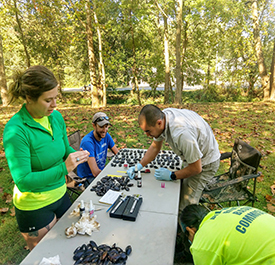 |
 |
 |
| DRBC and PDE staff measure and tag each mussel with an identifier at the beginning of the study. Photo by DRBC. |
One of the cages of freshwater mussels deployed in the Delaware River for this study. Photo by DRBC. |
DRBC staff install one of the freshwater mussel cages in the river. Photo by DRBC. |
- Delaware Wetland Monitoring and Assessment Program: Delaware's Freshwater Mussels
- Fairmount Water Works: Freshwater Mussel Hatchery
- Partnership for the Delaware Estuary: Freshwater Mussels
- Pennsylvania Fish and Boat Commission: A Field Guide to Pennsylvania's Freshwater Mussels
Copyright © Delaware River Basin Commission,
P.O. Box 7360, West Trenton, NJ 08628-0360
Phone (609)883-9500; Fax (609)883-9522
Thanks to NJ for hosting the DRBC website